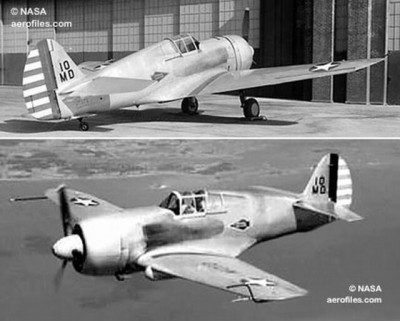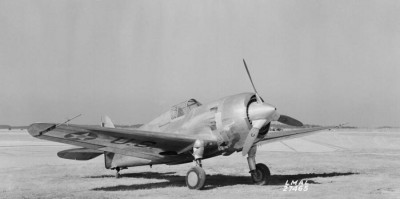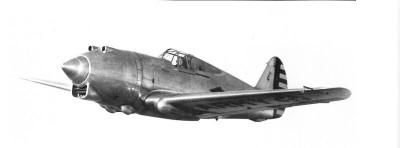| Název: Name: | Curtiss XP-42 | Curtiss XP-42 |
| Originální název: Original Name: | Curtiss XP-42 | |
| Kategorie: Category: | stíhací letoun | fighter aeroplane |
| Výrobce: Producer: | DD.MM.1939-DD.MM.1939 Curtiss-Wright Corp., Buffalo,New York | |
| Období výroby: Production Period: | DD.MM.1939-DD.MM.1939 | |
| Vyrobeno kusů: Number of Produced: | 1 (upraven z P-36A serial No. 38-004) | |
| První vzlet: Maiden Flight: | DD.03.1939 zahájeny zkoušky; 1942 - zkoušky ukončeny | |
| Osádka: Crew: | 1 | |
| Základní charakteristika: Basic Characteristics: | ||
| Vzlet a přistání: Take-off and Landing: | CTOL - konvenční vzlet a přistání | CTOL - conventional take-off and landing |
| Uspořádání křídla: Arrangement of Wing: | jednoplošník | monoplane |
| Uspořádání letounu: Aircraft Concept: | klasické | conventional |
| Podvozek: Undercarriage: | zatahovací | retractable |
| Přistávací zařízení: Landing Gear: | kola | wheels |
| Technické údaje: Technical Data: | ||
| Hmotnost prázdného letounu: Empty Weight: | 2185 kg | 4818 lb |
| Vzletová hmotnost: Take-off Weight: | 2685 kg | 5920 lb |
| Maximální vzletová hmotnost: Maximum Take-off Weight: | 2839 kg | 6260 lb |
| Rozpětí: Wingspan: | 11.37 m | 37ft 3,5in |
| Délka: Length: | 9.22 - 9.32 m | 30ft 3in - 30ft 7in |
| Výška: Height: | 3.66 m | 12ft |
| Plocha křídla: Wing Area: | 21.92 m2 | 236 ft2 |
| Plošné zatížení: Wing Loading: | 122,49 kg/m2 | 25.09 lb/ft2 |
| Pohon: Propulsion: | ||
| Kategorie: Category: | pístový | piston |
| Počet motorů: Number of Engines: | 1 | |
| Typ: Type: | Pratt & Whitney R-1830-31 Twin Wasp vzducem chlazený dvouhvězdicový čtrnáctiválec o vzletovém výkonu 783 kW. Vrtule: Hamilton Standard třílistá s konstantní rychlostí otáček. | Pratt & Whitney R-1830-31 Twin Wasp, fourteen-cylinder air-cooled two-row radial engine, rated at 1,050 hp for take-off, driving a three-blade Hamilton-Standard constant-speed propeller. |
| Objem palivových nádrží: Fuel Tank Capacity: | 397 l a 167 l v přídavné nádrži | 105 US gallons (87.3 UK gallons) and 44 US gallons (36.7 UK gallons) in drop tank. |
| Výkony: Performance: | ||
| Maximální rychlost: Maximum Speed: | 553.6 km/h v 4420 m | 344 mph in 14500 ft |
| Cestovní rychlost: Cruise Speed: | 460.3 km/h v ? m | 286 mph in ? ft |
| Rychlost stoupání: Climb Rate: | ? m/s | ? ft/min |
| Čas výstupu na výšku: Time to Climb to: | ? min do ? m | ? min to ? ft |
| Operační dostup: Service Ceiling: | 9601 m | 31500 ft |
| Dolet: Range: | 1174.8 km | 730 mi |
| Maximální dolet: Maximum Range: | 1931.2 km | 1200 mi |
| Výzbroj: Armament: | plánovaná: 1x pevný kulomet Colt-Browning MG-53 M2 ráže 12,7 mm s 200 náboji vpravo nad motorem a 1x pevný kulomet Colt-Browning AN-M2 ráže 7,62 mm s 500 náboji vlevo nad motorem. | proposed: One fixed forward-firing 0.5 inch Colt-Browning MG-53 M2 machine-gun right upper the engine with 200 rounds and one fixed forward-firing 0.3 inch Colt-Browning AN-M2 left upper the engine with 500 rounds. |
| Uživatelské státy: User States: | | |
| Poznámka: Note: | - | - |
| Zdroje: Sources: | - Archiv autora -P.M.Bowers:"Curtiss Aircraft 1907-1947"; Naval Institute Press rok 1979 - Profile No. 45 Curtiss Army Hawks-Peter M. Bowers-Profile rok 1965 - E.Angelucci a P.M.Bowers:"The American Fighter"; Orion Books NY rok 1987 - http://avia.russian.ee/air/usa/curtiss_p-42.html - http://www.aerofiles.com/_curtx.html | |
Curtiss XP-42
Let's face it, this aircraft was a dead end in the Curtiss fighter development line. The idea of building an aircraft derived from the Model 75 (whose airframe had considerable performance reserves), powered by a radial engine and matching the performance of fighters powered by inline engines, was born while the prototype Curtiss XP-37 was being tested. This aircraft was powered by an inline Allison, but its turbocharger was still rather a nuisance and it was at this time that the view could be, and was, promoted that by the time the Hawk 71 (Curtiss P-40), it would be advisable to produce a sort of bridging type with a radial engine, but cowled so closely that its aerodynamic drag would be comparable to an inline engine.
A fourth production aircraft was modified, the P-36A, and designated the Hawk 75S in late 1938. The modifications consisted mainly in the extension of the propeller shaft by 500 mm and this allowed to mount on the propeller a massive propeller cone, which was connected to the tight engine cowling, the work was successful in outline, but logically we then have the problem of engine cooling, in order to cool the engine sufficiently by air flow, a trap appeared under the engine and the upper part of the engine was cooled by enlarged holes in the machine gun covers. On 5 March 1939 the aircraft was handed over to the army pilots who immediately began to complain about the unbalance of the aircraft (500 mm extension in the front section), a quick solution was to load the rear section, but this in turn caused an increase in weight, and more weight inevitably leads to a decrease in performance. The maximum speed reached then did not exceed 505 km/h and in addition the engine was too warm. The aircraft therefore returned to the parent factory in Buffalo where it was modified by the Curtiss factory engineers, who worked closely with engineers from the Pratt & Whitney engine company. As a result, the lower trap was enlarged and the upper two after the machine guns were combined into one, slightly larger one. After only a few takeoffs, it was clear that even this cooling was not sufficient.
Blowdown in the NACA wind tunnel was to be of help. Several designs were made here, and all already had a common feature - they were at least minimally open in the front, and a fan provided forced airflow. The trials dragged on until late 1942, when it was clear to all that the XP-42, the military designation for the Hawk 75S, would not make it into production. Top speeds ranged from 544 to 553 km/h. Tests with engine covers were terminated with the knowledge that only a conventional open engine cover could provide sufficient airflow to keep the radial engine cool. The XP-42 continued to fly after the tests were completed, with floating tail surfaces being tested. Its career ended only in early 1947 - by scrapping.
Sources:
The Curtiss Hawk 75, Aircraft in Profile No. 80, Profile Publications, Ltd. 1966
Marek Ryś: "Curtiss P-36 Hawk"; AJ-Press 2002 ISBN 83-7237-057-5
Václav Němeček: "Vojenská letadla 3.díl"; Naše vojsko; Prague 1992
P.M.Bowers: "Curtiss Aircraft 1907-1947"; Naval Institute Press 1979
Profile No. 45 Curtiss Army Hawks-Peter M. Bowers-Profile year 1965
E.Angelucci and P.M.Bowers: "The American Fighter"; Orion Books NY year 1987
http://avia.russian.ee/air/usa/curtiss_p-42.html
http://www.aerofiles.com/_curtx.html
author's archive
This post has not been translated to English yet. Please use the TRANSLATE button above to see machine translation of this post.
nahoře: první řešení
druhý obrázek: druhé řešení - zbraně jsou odstraněny
snímky dole: dvě verze z pozdních zkouček
www.geocities.com
http://avia.russian.ee/air/usa/curtiss_p-42.html
http://www.aerofiles.com/curt-p42tail.jpg
archiv autora
| Period | - |
| Producer | - |
| Type | - |
| Camouflage | - |
| Country | - |
| Pilot | - |
| Production No. | - |
| Serial No. / Evidence No. | - |
| Tactical Marking / Imatriculation | - |
| Name | - |
| Unit | - |
| Base | - |
| Date (DD.MM.RRRR) | - |
| Author | - |
| Print size / 300 DPI | - |
| Published with authors permit | - |
| Author Website | - |
| Period | - |
| Producer | - |
| Type | - |
| Camouflage | - |
| Country | - |
| Pilot | - |
| Production No. | - |
| Serial No. / Evidence No. | - |
| Tactical Marking / Imatriculation | - |
| Name | - |
| Unit | - |
| Base | - |
| Date (DD.MM.RRRR) | - |
| Author | - |
| Print size / 300 DPI | - |
| Published with authors permit | - |
| Author Website | - |
| Period | - |
| Producer | - |
| Type | - |
| Camouflage | - |
| Country | - |
| Pilot | - |
| Production No. | - |
| Serial No. / Evidence No. | - |
| Tactical Marking / Imatriculation | - |
| Name | - |
| Unit | - |
| Base | - |
| Date (DD.MM.RRRR) | - |
| Author | - |
| Print size / 300 DPI | - |
| Published with authors permit | - |
| Author Website | - |
| Period | - |
| Producer | - |
| Type | - |
| Camouflage | - |
| Country | - |
| Pilot | - |
| Production No. | - |
| Serial No. / Evidence No. | - |
| Tactical Marking / Imatriculation | - |
| Name | - |
| Unit | - |
| Base | - |
| Date (DD.MM.RRRR) | - |
| Author | - |
| Print size / 300 DPI | - |
| Published with authors permit | - |
| Author Website | - |
This post has not been translated to English yet. Please use the TRANSLATE button above to see machine translation of this post.
| Period | - |
| Producer | - |
| Type | - |
| Camouflage | - |
| Country | - |
| Pilot | - |
| Production No. | - |
| Serial No. / Evidence No. | - |
| Tactical Marking / Imatriculation | - |
| Name | - |
| Unit | - |
| Base | - |
| Date (DD.MM.RRRR) | - |
| Author | - |
| Print size / 300 DPI | - |
| Published with authors permit | - |
| Author Website | - |
This post has not been translated to English yet. Please use the TRANSLATE button above to see machine translation of this post.
| Period | - |
| Producer | - |
| Type | - |
| Camouflage | - |
| Country | - |
| Pilot | - |
| Production No. | - |
| Serial No. / Evidence No. | - |
| Tactical Marking / Imatriculation | - |
| Name | - |
| Unit | - |
| Base | - |
| Date (DD.MM.RRRR) | - |
| Author | - |
| Print size / 300 DPI | - |
| Published with authors permit | - |
| Author Website | - |
Join us
We believe that there are people with different interests and experiences who could contribute their knowledge and ideas. If you love military history and have experience in historical research, writing articles, editing text, moderating, creating images, graphics or videos, or simply have a desire to contribute to our unique system, you can join us and help us create content that will be interesting and beneficial to other readers.
Find out more




